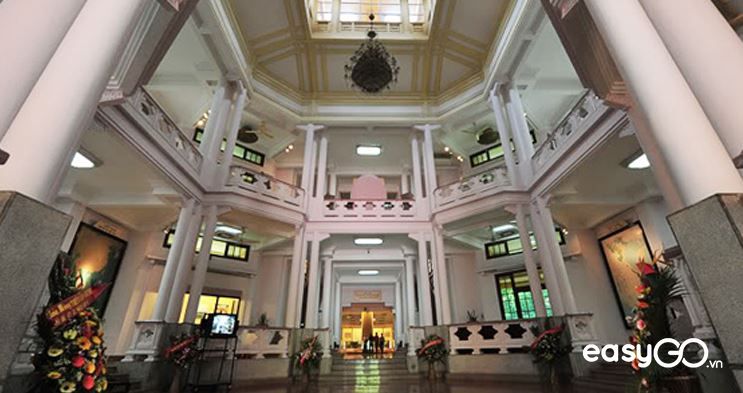Vietnam History Museum - A journey to find the nation's past
Vietnam History Museum is considered "a living history book in the heart of Hanoi" to demonstrate the glorious past of the whole nation.
If you miss the opportunity to explore this place, you will not be able to know how wonderful the things that existed in the past are. Let's explore this seemingly "boring" but extremely interesting place right now!
History of formation and address of Vietnam History Museum
In the system of National Museums of Vietnam, the Vietnam History Museum was established the earliest based on inheriting the Louis Finotdo Museum of the Vien Dong Bac Co School. The museum was built by the French and was established on September 3, 1958.
This "history of living in the heart of Hanoi" is located at No. 1 at the corner of Trang Tien street, Pham Ngu Lao. With an area of over 4000m2 to display more than 10,000 artifacts in the main exhibition area, along with the outdoor display, this place day and night preserve pages of national history through images of old artifacts.
Cost to visit the museum: 30,000 VND for a ticket (If you have a student/student card, the ticket price is 15,000 VND)
Note: On the first Monday of every month, the museum is closed.
Architecture and design of the campus of the Vietnam History Museum
Vietnam History Museum consists of two parallel campuses, zone A located at 1 Trang Tien Street and zone B located at 25 Tong Dan street.
The image of Area A stands out at the beginning of Trang Tien Street with its orange façade combining typical French-style column-arch architecture with curved roofs and hexagonal towers commonly found in Chinese temples. Both the interior and exterior of the building are decorated with statues of gods of the Khmer and Champa kingdoms.
Memories exist inside the artifacts at the museum
Stepping inside area A, the museum opens up to visitors a wide and deep space.
The main display system of the Museum follows the principle of the chronological display, which is mainly expressed through the richness of the collection of artifacts, along with a combination of displays reflecting historical periods and events with exhibits. The collection is displayed openly, giving viewers an overview of Vietnam's history.
In the exhibition space on the first floor is a system of artifacts with the theme of Vietnam in Prehistory (30-40 thousand years ago) and Vietnam from the time of nation-building to the Tran dynasty.
Visitors to the museum will be especially attracted by the image of 7 bronze drums: Dong Son bronze drum, Ngoc Lu bronze drum, Nong Cong bronze drum, Thanh Vinh bronze drum, etc., arranged around a large pillar carved with the image of a crane and ancient Vietnamese, famous cultural symbols of Vietnam.
At the 2nd-floor exhibition space displaying a model of a turtle with a stele, looking to the two sides, visitors will see portraits of cultural celebrity Nguyen Trai and ancient books arranged squarely in the center.
Going from the right, there is a space in the middle for visitors to visit along both sides of the exhibition space. Here viewers can go back in time, re-imagining the entire history of Vietnam under the Ho Dynasty. , the Le dynasty - Mac - Le Trung Hung, the Tay Son dynasty, to the Nguyen dynasty.
Also on the 2nd floor of Area A, the museum has 2 permanent thematic galleries: Champa stone art sculpture and Oc Eo culture - Phu Nam.
It is also quite new and unique when the Champa stone collection is presented in an open space right in the corridor on the 2nd floor of the octagonal room looking down at the museum lobby. Through each chronology stretching from the 7th to the 13th centuries, with more than 50 specimens collected from provinces such as Quang Binh, Quang Nam, Binh Dinh, the collection attracts many people to observe and learn.
In parallel, at the B Museum on Tong Dan Street, visitors will visit from the 2nd floor and then to the 1st floor. The space here includes 29 small rooms, where documents are kept, presently present. objects and pictures of the struggle for national independence from 1858 - 1945 and the period our country spent 30 years of resistance war, independence, and reunification (1945-1975).
It seems that visiting a museum is something dry and less interesting, but maybe you will feel different things and change your mind?
Step by step walking beside the pages of the nation's history, witnessing and learning about our roots is a way for us to love and appreciate more what we have in the present. Coming to the Vietnam History Museum is not only a way to hone your historical knowledge, but through it, you will have a fun and rewarding weekend outing.
In addition, Easygo also provides you with additional information that for only 15,000 VND, you can be allowed to take photos in the museum. Please try to save as many pictures and share them with Easygo. Wish you have a pleasant visit and lots of fun!









Đăng nhận xét